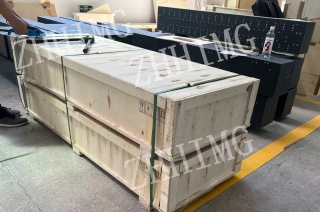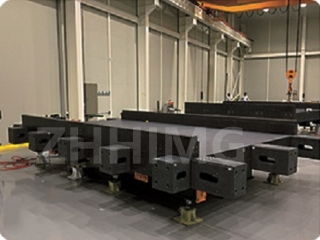In fields such as chip manufacturing and precision measurement, the properties of materials directly determine the accuracy of equipment. Granite, with its five core characteristics, stands out from materials such as metals, engineering plastics and ceramics, and has become the "golden partner" of high-end equipment.
1. Thermal stability: The "immune" to Temperature fluctuations
For every 1℃ change in temperature, stainless steel expands by 17μm/m, aluminum alloy expands by 23μm/m, while granite only expands by 4-8μm/m. In semiconductor factories, the high temperatures generated by the operation of photolithography machines or the temperature differences between the start and stop of air conditioners have almost negligible effects on the dimensions of granite. In contrast, the deformation of metals and plastics due to thermal expansion and contraction can easily cause misalignment of precision components.
2. Vibration resistance: The "Devourer" of vibration energy
Granite has a high density (2.6-3.1g/cm³), a hardness of 6-7 on the Mohs scale, and a damping ratio 5-10 times that of stainless steel. In precision measuring equipment, it can attenuate 90% of the vibration energy within 0.5 seconds, while metal materials require 3 to 5 seconds. The vibrations generated by the operation of equipment and the movement of personnel in the workshop are difficult to shake the stability of the equipment supported by granite.
3. Chemical stability: The "stubborn" in acidic and alkaline environments
When granite is soaked in a strong acid (pH=2) or strong alkali (pH=12) solution for 1000 hours, the surface corrosion amount is less than 0.01μm. Stainless steel is prone to corrosion by acids and alkalis, aluminum alloy is afraid of alkaline substances, and engineering plastics will swell when exposed to organic solvents. Granite's dense structure (porosity < 0.1%) can also prevent particle contamination, making it the "chosen material" for semiconductor cleanrooms.
4. Processing and Cost: The "Master of Balance" between Precision and Cost Performance
Granite can be ground to a flatness of ≤0.5μm/m and a surface roughness Ra of ≤0.05μm, but the processing takes a relatively long time. Stainless steel is easy to process but prone to deformation, while ceramics have high precision but are expensive. In scenarios that pursue nanoscale precision, the comprehensive cost performance of granite far exceeds that of other materials.
5. Electromagnetic Purity: The "Cleaner" of Electronic Devices
As a non-metallic material, granite is non-magnetic and non-conductive, and will not interfere with sensors and electronic components. The electrical conductivity and magnetism of metals, the static electricity of engineering plastics, and the dielectric loss of ceramics all become "weak points" in the face of precision equipment such as photolithography machines and nuclear magnetic resonance machines. However, granite is perfectly suitable for electromagnetic sensitive environments.
From high-temperature resistance to vibration resistance, from corrosion prevention to zero electromagnetic interference, granite has proven with its hard-core properties that in the field of precision manufacturing, it is the irreplaceable "king".
Post time: May-20-2025


